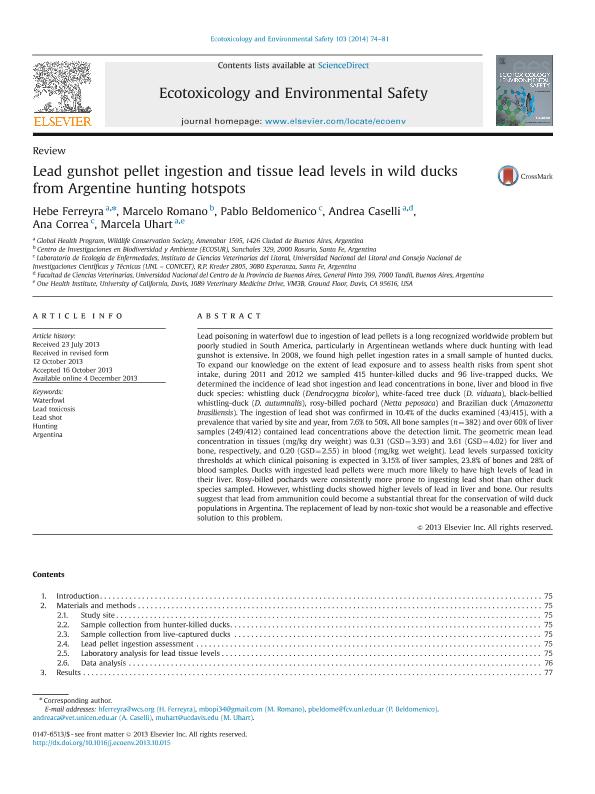Mostrar el registro sencillo del ítem
dc.contributor.author
Ferreyra, Hebe
dc.contributor.author
Romano, Marcelo
dc.contributor.author
Beldomenico, Pablo Martín

dc.contributor.author
Caselli, Andrea
dc.contributor.author
Correa, Ana
dc.contributor.author
Uhart, Marcela Maria

dc.date.available
2017-07-12T21:12:07Z
dc.date.issued
2014-05
dc.identifier.citation
Ferreyra, Hebe; Romano, Marcelo; Beldomenico, Pablo Martín; Caselli, Andrea; Correa, Ana; et al.; Lead gunshot pellet ingestion and tissue lead levels in wild ducks from Argentine hunting hotspots; Elsevier; Ecotoxicology and Environmental Safety; 103; 5-2014; 74-81
dc.identifier.issn
0147-6513
dc.identifier.uri
http://hdl.handle.net/11336/20294
dc.description.abstract
Lead poisoning in waterfowl due to ingestion of lead pellets is a long recognized worldwide problem but poorly studied in South America, particularly in Argentinean wetlands where duck hunting with lead gunshot is extensive. In 2008, we found high pellet ingestion rates in a small sample of hunted ducks. To expand our knowledge on the extent of lead exposure and to assess health risks from spent shot intake, during 2011 and 2012 we sampled 415 hunter-killed ducks and 96 live-trapped ducks. We determined the incidence of lead shot ingestion and lead concentrations in bone, liver and blood in five duck species: whistling duck (Dendrocygna bicolor), white-faced tree duck (D. viduata), black-bellied whistling-duck (D. autumnalis), rosy-billed pochard (Netta peposaca) and Brazilian duck (Amazonetta brasiliensis). The ingestion of lead shot was confirmed in 10.4% of the ducks examined (43/415), with a prevalence that varied by site and year, from 7.6% to 50%. All bone samples (n=382) and over 60% of liver samples (249/412) contained lead concentrations above the detection limit. The geometric mean lead concentration in tissues (mg/kg dry weight) was 0.31 (GSD=3.93) and 3.61 (GSD=4.02) for liver and bone, respectively, and 0.20 (GSD=2.55) in blood (mg/kg wet weight). Lead levels surpassed toxicity thresholds at which clinical poisoning is expected in 3.15% of liver samples, 23.8% of bones and 28% of blood samples. Ducks with ingested lead pellets were much more likely to have high levels of lead in their liver. Rosy-billed pochards were consistently more prone to ingesting lead shot than other duck species sampled. However, whistling ducks showed higher levels of lead in liver and bone. Our results suggest that lead from ammunition could become a substantial threat for the conservation of wild duck populations in Argentina. The replacement of lead by non-toxic shot would be a reasonable and effective solution to this problem.
dc.format
application/pdf
dc.language.iso
eng
dc.publisher
Elsevier

dc.rights
info:eu-repo/semantics/openAccess
dc.rights.uri
https://creativecommons.org/licenses/by-nc-nd/2.5/ar/
dc.subject
Waterfowl
dc.subject
Lead Toxicosis
dc.subject
Lead Shot
dc.subject
Hunting
dc.subject
Argentina
dc.subject.classification
Otras Ciencias Veterinarias

dc.subject.classification
Ciencias Veterinarias

dc.subject.classification
CIENCIAS AGRÍCOLAS

dc.title
Lead gunshot pellet ingestion and tissue lead levels in wild ducks from Argentine hunting hotspots
dc.type
info:eu-repo/semantics/article
dc.type
info:ar-repo/semantics/artículo
dc.type
info:eu-repo/semantics/publishedVersion
dc.date.updated
2017-07-07T20:07:34Z
dc.journal.volume
103
dc.journal.pagination
74-81
dc.journal.pais
Países Bajos

dc.journal.ciudad
Amsterdam
dc.description.fil
Fil: Ferreyra, Hebe. Wildlife Conservation Society; Estados Unidos
dc.description.fil
Fil: Romano, Marcelo. Centro de Investigaciones en Biodiversidad y Ambiente; Argentina
dc.description.fil
Fil: Beldomenico, Pablo Martín. Consejo Nacional de Investigaciones Científicas y Técnicas. Centro Científico Tecnológico Conicet - Santa Fe. Instituto de Ciencias Veterinarias del Litoral. Universidad Nacional del Litoral. Facultad de Cs.veterinarias. Instituto de Ciencias Veterinarias del Litoral; Argentina
dc.description.fil
Fil: Caselli, Andrea. Wildlife Conservation Society; Estados Unidos. Universidad Nacional del Litoral. Facultad de Ciencias Veterinarias; Argentina
dc.description.fil
Fil: Correa, Ana. Consejo Nacional de Investigaciones Científicas y Técnicas. Centro Científico Tecnológico Conicet - Santa Fe. Instituto de Ciencias Veterinarias del Litoral. Universidad Nacional del Litoral. Facultad de Cs.veterinarias. Instituto de Ciencias Veterinarias del Litoral; Argentina
dc.description.fil
Fil: Uhart, Marcela Maria. Wildlife Conservation Society; Estados Unidos. University of California; Estados Unidos
dc.journal.title
Ecotoxicology and Environmental Safety

dc.relation.alternativeid
info:eu-repo/semantics/altIdentifier/url/http://www.sciencedirect.com/science/article/pii/S0147651313004405
dc.relation.alternativeid
info:eu-repo/semantics/altIdentifier/doi/http://dx.doi.org/10.1016/j.ecoenv.2013.10.015
Archivos asociados
